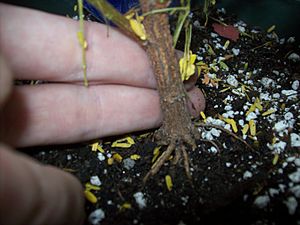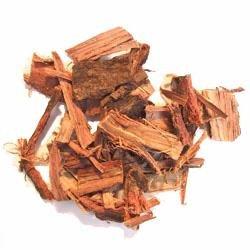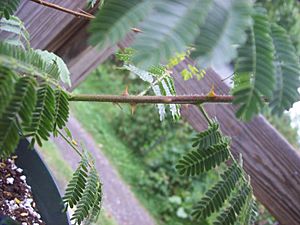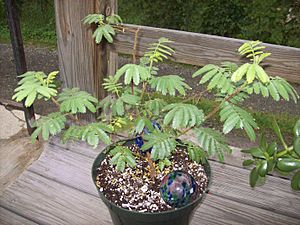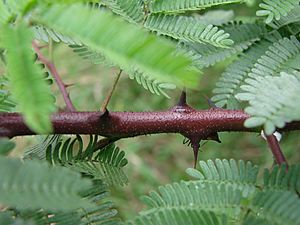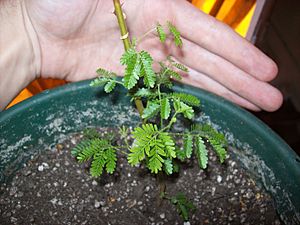Jurema preta facts for kids
Quick facts for kids Jurema preta |
|
|---|---|
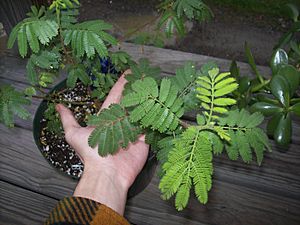 |
|
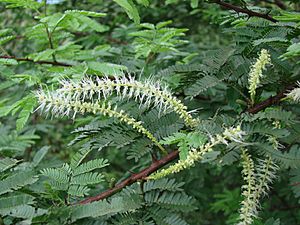 |
|
| Mimosa tenuiflora | |
| Scientific classification | |
| Genus: |
Mimosa
|
| Species: |
tenuiflora
|
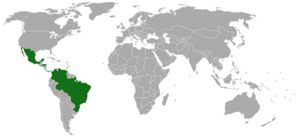 |
|
| Range of Mimosa tenuiflora | |
| Synonyms | |
The Mimosa tenuiflora, also known as jurema preta or tepezcohuite, is a type of tree or shrub that lives for many years. It grows naturally in the northeastern part of Brazil and stretches north to southern Mexico. You can also find it in countries like El Salvador, Honduras, Panama, Colombia, and Venezuela. This plant usually grows in lower areas, but it can be found as high as 1,000 meters (about 3,280 feet) above sea level.
Contents
Discovering the Mimosa Tenuiflora Tree
This tree has branches that look a bit like ferns. Its leaves are very fine and grow up to 5 centimeters (about 2 inches) long. Each leaf has 15 to 33 pairs of bright green smaller leaflets, each about 5 to 6 millimeters (0.2 inches) long.
The Mimosa tenuiflora tree can grow quite tall, reaching up to 8 meters (about 26 feet). It can even grow 4 to 5 meters (13 to 16 feet) in less than five years! Its white, sweet-smelling flowers grow in long, loose clusters that are 4 to 8 centimeters (1.6 to 3.1 inches) long.
When the Mimosa Tenuiflora Blooms
In the Northern Hemisphere, the tree blossoms and produces fruit from November to June or July. In the Southern Hemisphere, it mostly blooms from September to January. The fruit pods are delicate and measure about 2.5 to 5 centimeters (1 to 2 inches) long. Each pod holds 4 to 6 seeds. These seeds are oval, flat, light brown, and about 3 to 4 millimeters (0.12 to 0.16 inches) wide. There are about 145 seeds in one gram. In the Southern Hemisphere, the fruit becomes ripe from February to April.
The tree's bark is dark brown to gray and splits lengthwise. The inside of the bark is reddish brown. The wood of the tree is also dark reddish brown with a yellow center. It is very strong and heavy.
How Mimosa Tenuiflora Helps Nature
Mimosa tenuiflora grows very well after a forest fire or other big natural event. It is a strong pioneer plant, meaning it's one of the first plants to grow in a disturbed area. It drops its leaves, which create a layer of mulch on the ground. This mulch eventually turns into humus, a rich soil material. The tree also helps the soil by adding nitrogen, making it ready for other plants to grow.
Medicinal Uses of Mimosa Tenuiflora
People have used this plant for a long time in traditional medicine. A tea made from its leaves and stem has been used to help with tooth pain. For coughs and bronchitis, people drink a water extract (called a decoction) made from Mimosa tenuiflora. They might use a handful of bark in one liter of water, either by itself or in a syrup, until they feel better.
Some early studies have shown that Mimosa tenuiflora might help heal leg ulcers. Extracts from the plant are also widely used in Central and South America for healing wounds and burns. Because of these healing properties, products from the plant, often called "Tepezcohuite," have become popular in skincare.
Other Ways Mimosa Tenuiflora Is Used
This tree is a good source of food for animals, like cows, goats, and sheep, especially during dry seasons and droughts. They eat its pods and leaves, which provide important protein and nutrients. However, there is some information that suggests eating Mimosa tenuiflora might cause problems for pregnant ruminant animals in Brazil.
The tree is also a key source of food for bees, especially when other plants are scarce.
Mimosa Tenuiflora and Soil Health
Like most plants in the pea family (Fabaceae), Mimosa tenuiflora helps make the soil healthier. It does this by working with special bacteria that add nitrogen to the soil. This tree is also helpful in stopping soil from washing away (erosion) and for planting new forests.
The wood of Mimosa tenuiflora is excellent for fuel and for making fence posts. This is likely because it has a lot of tannins, which protect the wood from rotting. The bark, rich in tannins (about 16%), is also used as a natural dye and in making leather. People use the wood to build bridges, buildings, fences, furniture, and even wheels. It's also a great source for making charcoal.
Benefits for Animals and Shade
The healing properties of the tree are also used to treat farm animals. A solution made from the leaves or bark can be used to wash animals to help prevent parasites. Since the tree keeps most of its leaves during the dry season, it provides important shade for animals and other plants during hot times.
Chemistry of Mimosa Tenuiflora
The bark of Mimosa tenuiflora is known to contain many natural chemicals. These include tannins, saponins, alkaloids, and other helpful compounds.
Traditional Cultural Uses
In northeastern Brazil, Mimosa tenuiflora is used in traditional ceremonies by the Jurema Cult. The dried root bark from Mexico has been found to contain a substance called dimethyltryptamine (DMT). The stem bark also contains a small amount of DMT.
Parts of the tree are traditionally used in northeastern Brazil to make a special drink called Jurema or Yurema. This drink is important in their cultural practices.
Growing Mimosa Tenuiflora
If you want to plant Mimosa tenuiflora outside, it's best to be in a warm area, like USDA Zone 9 or warmer.
In nature, the tree's fruits and seeds are spread by the wind, usually within 5 to 8 meters (16 to 26 feet) of the parent plant. Rain can also carry them down slopes to lower areas, and human activities help spread them too.
How to Plant Mimosa Tenuiflora Seeds
To grow the tree, you collect the seed pods when they start to open on the tree. Then, you lay the collected pods in the sun so they open up and release their seeds. These seeds can then be planted in sandy soil where they will get plenty of sun.
Making small scratches on the seed (called scarification) or using a weak acid can greatly help the seeds sprout. You can plant the seeds directly into holes in the ground or in specially prepared areas.
The seeds can sprout in temperatures from 10 to 30 °C (50 to 86 °F), but they sprout best at around 25 °C (77 °F), with about 96% of seeds growing. Seeds can even sprout well after being stored for four years. It usually takes about 2 to 4 weeks for the seeds to sprout.
You can also grow Mimosa tenuiflora from cuttings. However, it's not a good idea to trim older Mimosa tenuiflora trees during the rainy season, as this can cause them to die.
See also
 In Spanish: Mimosa tenuiflora para niños
In Spanish: Mimosa tenuiflora para niños


